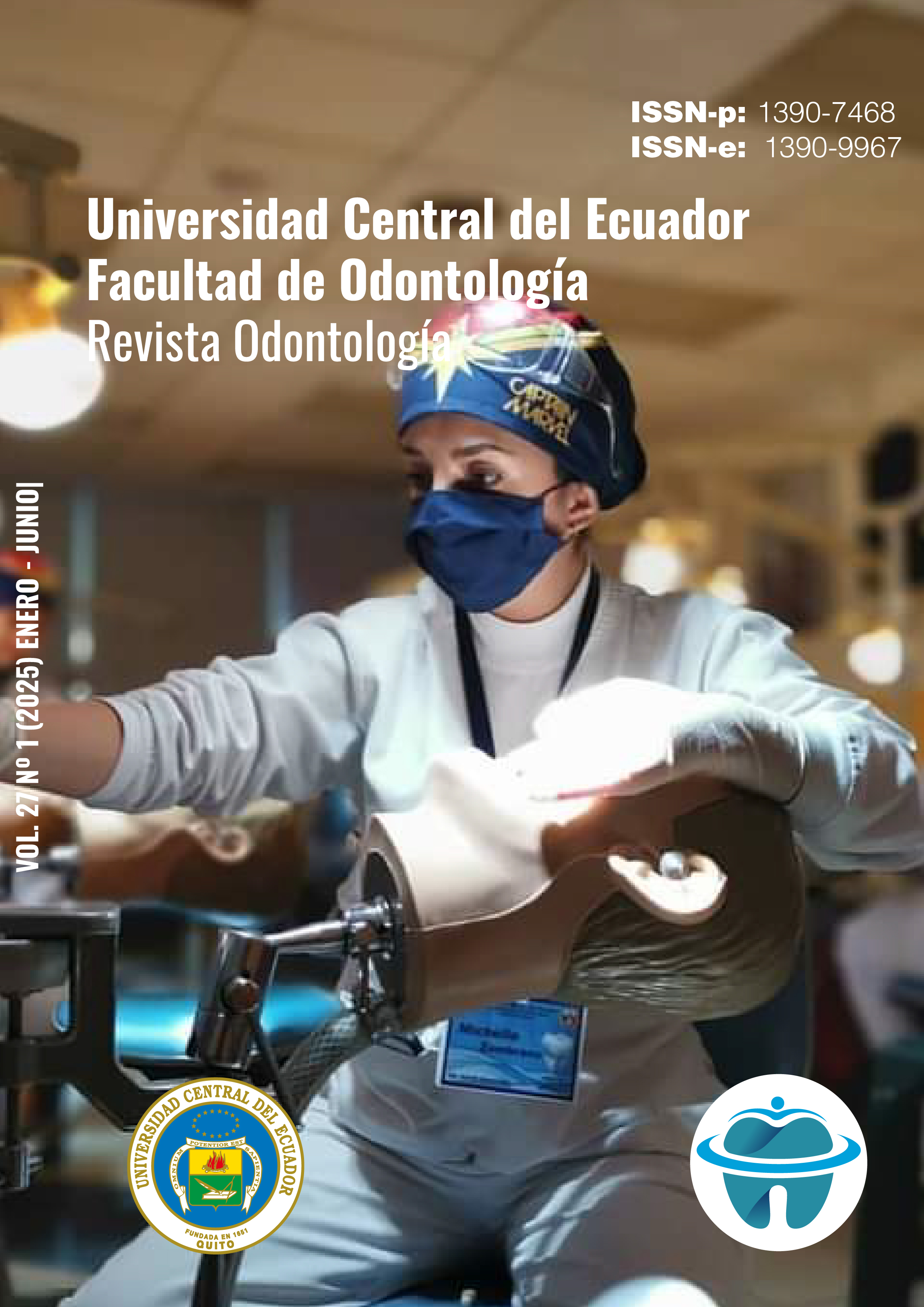Actitud y conducta sobre higiene oral de estudiantes de odontología ecuatorianos
DOI:
https://doi.org/10.29166/odontologia.vol27.n1.2025-e7602Keywords:
Attitude, Behavior, Oral hygiene, Habits, Dental studentsAbstract
Oral health is a key element in overall health and well-being of people. We expected that dental students will have a good attitude and behavior toward oral care. We aimed to evaluate the attitude and behavior regarding oral hygiene among dentistry students at public university in Ecuador, during the 2022-2022 period. To achieve this goal, we used the Hiroshima University Dental Behavior Inventory index (HU-DBI) to evaluate 277 students of first to ninth semesters. Between the main findings, we identified that the 57,76% of students had a good attitude and behavior, followed by 41,25% at a regular level and 0,72% at a poor level. Chi-square statistical analysis revealed significant findings among ninth-level students, who had favorable attitudes and behaviors. We conclude that more than 50% of surveyed students demonstrate positive attitudes and behaviors. There was not a statistical significance about gender, but we identified a statistical significance relationship with education level, indicating that higher educational levels are associated with better attitudes.
Downloads
References
Organización Mundial de la Salud. Informe sobre la situación mundial de la salud bucodental: hacia la cobertura sanitaria universal para la salud bucodental de aquí a 2030. Resumen ejecutivo. Informe de la OMS. Washington, D.C.: OMS; 2022.
Lafebre Carrasco F, Cobos Carrera D, Arévalo C, Charry R, Torrachi Carrasco AM. Actitudes y Conductas de Salud Oral de Estudiantes de Odontología de la Universidad de Cuenca 2014. Acta Odontológica Colomb. 2015; 5(2).
FDI World Dental Federation. Política Nacional de Salud. [Online].; 2018 [cited 2022. Available from: https://www.fdiworlddental.org/es/politica-nacional-de-salud#:~:text=Por%20su%20parte%2C%20la%20FDI,enfermedad%20del%20complejo%20craneofacial4.
FDI World Dental Federation. El desafío de las enfermedades bucodentales. Una llamada a la acción. Atlas de salud bucodental. Segunda ed. Benzian H, Williams D, Séverin T, editors. Brighton, RU: Myriad editions; 2015.
Glick M, Williams D, Kleinman D, Vujicic M, Watt R, Weyant R. A new definition for oral health developed by the FDI World Dental Federation opens the door to a universal definition of oral health.. The Journal of the American Dental Association. 2016.
Parise-Vasco JM, Zambrano-Achig P, Viteri-García A, Armas-Vega A. Estado de la salud bucal en el Ecuador. Odontología Sanmarquina. 2020; 23(3).
Tennert C, Reinmuth A, Bremer K, Al-Ahmad A, Karygianni L, Hellwig E, et al. An oral health optimized diet reduces the load of potential cariogenic and periodontal bacterial species in the supragingival oral plaque: A randomized controlled pilot study. Microbiology Open. 2020; 9(8).
Mejías L, Iriarte D, Sánchez R, Neira I, Bravo J. Comparison of Total Anaerobic Microbiota in Periodontitis Before and After the Subgingival Irrigation with Chlorhexidine at 0.12 %. Int. J. Odontostomat. 2019; 13(4).
World Health Organization. Global oral health status report. Towards universal health coverage for oral health by 2030. Report. Geneva: World Health Organization; 2022. Report No.: CC BY-NC-SA 3.0 IGO.
Ministerio de salud Pública. Estudio Epidemiológico Nacional de Salud Bucal en escolares menores de 15 años en el Ecuador. Quito – Ecuador 2009/2010. Resultados de estudio epidemiológico. Quito: Ministerio de Salud Pública del Ecuador; 2010.
MSP, INEC, OPS/OMS. Encuesta STEPS Ecuador 2018. Vigilancia de enfermedades no transmisibles y factores de riesgo. Informe de resultados. Quito: Ministerio de Salud Pública, INEC, OPS/OMS; 2018.
Fortich-Mesa N, Hoyos-Hoyos V, Romero-Anaya A, Muñoz-Viloria D, Alarcón-Vitóla K, Herrera-Vanegas L. Conocimientos, creencias y prácticas sobre el flúor en padres y docentes de escolares. Ustasalud. 2020; 19.
Carrera A, Scacco J, Alarcón R, Núñez A, Armas Vega AdC. Hábitos de higiene oral en los estudiantes de odontología que realizan sus prácticas clínicas en la Universidad Tecnológica Equinoccial. Revista Kiru. 2017; 14(1).
Arrieta Vergara KM, Díaz Caballero , González Martínez. Prevalencia de caries y enfermedad periodontal en estudiantes de odontología. Rev Cubana Estomatol. 2011; 48(1).
Solórzano Arévalo I, Rocha Navarro ML, Lepe Zúñiga VJ. Salud oral en estudiantes de odontología de México / Oral health in dental students from Mexico. Rev. ADM. 2007; 64(5).
Padilla-Ávalos C, Marroquín-Soto C. Impacto de la pandemia del COVID-19 sobre la salud estomatológica. Rev Estomatol Herediana. 2021; 31(1).
López Soto , González Rodríguez M, Mena Chacón , Muñoz Esquivel M, Soto Maltez. Impacto de la COVID-19 en los modelos educativos en odontología: revisión de literatura. Revista iDental, ULACIT-Costa Rica. 2020; 12(1).
Cayo-Rojas CF, Agramonte-Rosell R. Desafíos de la educación virtual en Odontología en tiempos de pandemia COVID-19. Revista Cubana de Estomatología. 2020; 57(3).
Durán-Ojeda G. Preclinical simulation courses in dental education with COVID-19 pandemic. Odovtos - Int J Dent Sci. 2020; 22(2).
Barzallo M, Flores V, Ushiña V, Zurita C C, Luna Chonata DV. Recomendaciones para la atención odontológica en el marco de la pandemia por COVID-19. Quito: MSP, IESS, FFAA, FOE, SESP, ACESS, COE Nacional; 2020.
Al-Shiekh , Muhammed ED, Muhammed AER, El-Huda M, Hashim. Evaluation of dental students' oral hygiene attitude and behavior using HU-DBI in Sudan. Sci Postprint. 2014; 1(2).
Polychronopoulou A, Kawamura M. Oral self-care behaviours: comparing Greek and Japanese dental students. Eur J Dent Educ. 2005; 9(4).
Guevara-Veliz DN, Flores-Joaquin KM, Maturrano-Santos AG, Mattos-Vela MA. Educación virtual en odontología durante la pandemia de COVID-19. Rev Cient Odontol Lima. 2021; 9(3).
Neeraja R, Kayalvizhi G, Sangeetha P. Oral Health Attitudes and Behavior among a Group of Dental Students in Bangalore, India. Eur J Dent. 2011; 5(2).
Haghi S, Haghi H, Bagheri A, Karimzadeh N. A Comparative Study of Oral Health Attitude and Behavior of Dental and Public Health Students in Ardabil, Iran Using the Hiroshima University-Dental Behavioral Inventory. Journal of International Oral Health. 2020; 12(3).
Rong WS, Wang WJ, Yip HK. Attitudes of dental and medical students in their first and final years of undergraduate study to oral health behaviour. Eur J Dent Educ. 2006; 10(3).
Published
How to Cite
Issue
Section
License
Copyright (c) 2025 David Parra-Rosero, Darwin Luna-Chonata, Ximena Molina-Jaramillo, Cecilia Molina-Jaramillo

This work is licensed under a Creative Commons Attribution-NonCommercial-NoDerivatives 4.0 International License.


